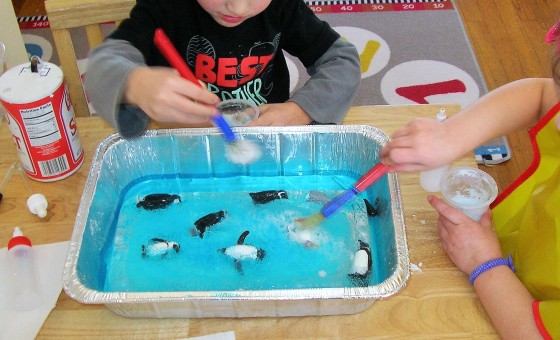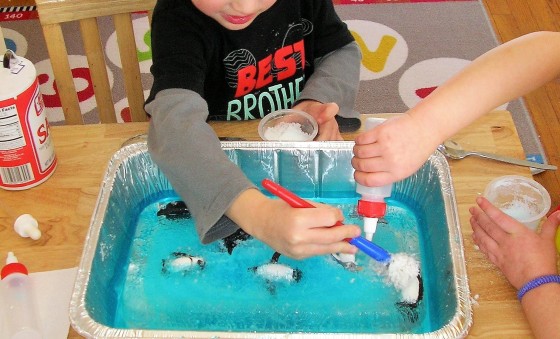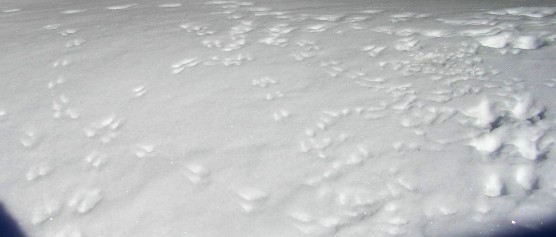My Five Senses is one of my favorite preschool lessons/themes because the children have so much fun while learning. I usually like to extend it at least two weeks, so we can focus on one sense at a time, and we always begin with the sense of touch.
Since there are plenty of resources out there for related books andnprintables, this post focuses on a few quick hands-on activities.
Sense of Touch Mystery Bag

Sense of Touch Mystery Bag
Supplies:
-Any type of drawstring bag or pouch (fabric recommended)
-Assorted objects and toys to be identified by the children (at least three items per child for multiple turns and level of difficulty based on the age of the group). Examples from photo above: puzzle piece, toy dinosaur, straw, spoon, comb, marker, rock, Lego, bean bag, cup, key, toy train, and magnifying glass.
-A blindfold (or individual blindfolds per child)
Note: We usually play this game during circle time, and children always want to repeat it another day with a new set of objects (plus a few from the first game just to give others a chance to identify them). It’s a game that can be used throughout the year just for fun after your Five Senses unit is over.

It’s a key!
Process:
-Taking turns, each child is blindfolded and reaches into the bag to pull out an object to identify only with his hands (sense of touch).
-To help solidify the concept of senses, the teacher reminds children that we are only using our hands and sense of touch to guess the object.
Sense of Smell Guessing Game

Sense of Smell Guessing Game
Supplies:
-A set of small plastic jars (my package of 6 were from the Dollar Store)
-Cotton balls
–A set of photo cards that correspond with the scents you will be using (I used Google images, inserted them into a document, printed them, and laminated). Download a copy of my photo page below:
Five Senses – Sense of Smell Photos
-Assorted spices or scented foods/items you may have at home
Note: The scents/photos I chose depicted items children would know and be able to identify. Examples I used: Italian seasoning blend to match a photo of a pizza; cinnamon/clove to match a photo of a gingerbread man (which we baked earlier in the year); onion powder to match photo of red onions on a salad; vanilla extract to match a photo of vanilla cookie; lemon juice/zest to match a photo of lemonade; and finally a little Dr. Bronner’s peppermint liquid soap (that we use in the classroom) to match the peppermint candy canes.
-A blindfold (or individual blindfolds per child)
-A tray
Set-Up Process:
-Add small cotton ball (or cut large in half) to insert into jar
-Sprinkle a small amount of spices or scented liquid on cotton ball
-Drip a small amount of hot water over spices, so they will be wet and stay in place to prevent scattering or inhaling once opened.
-Cover and place in refrigerator overnight – take out and place on counter in morning to be at room temperature for your guessing game.

What does it smell like?
Play Process:
-Explain that you’ll be using only your sense of smell (nose) to guess the items. Show the children the photo cards and name them to allow them to get a sense of what they will be identifying.
-One child at a time is blindfolded and the teacher shows the other children the photo/scent they will be guessing before opening the container and placing it under the child’s nose. Remind children beforehand not to say the word out loud, although this WILL happen. We just say, “oops, let’s pick another one,” and remind children again to not give any clues. We had six different scents, as our group has six children.
-Once each child has had one turn demonstrated by the teacher, you can then ask the children to take turns holding the scented container under a friend’s nose. Participation by the children helps the waiting factor and increases the fun, as they are excited to help and find out what their friend will guess.
Math Extension: Graphing favorite and least favorite scents.
Sense of Taste – Taste Test Experiment

Is it salty, sweet, or sour?
My group of preschoolers get excited about any type of experiment, so that’s what we called this taste test. We conducted our experiment at our usual snack time.
After reading and talking about taste buds, we all took turns looking through magnfiying glasses at each other’s tongues. I explained that our taste buds would help us find out which food item would be salty, sweet, or sour. Can a food be more than one? Let’s find out!
(We skipped bitter, because no child wants to taste unsweetened cocoa powder.)
Supplies:
-A selection of foods (salty, sweet, sour) that are readily available and children would be willing to taste. We used salty pretzels, sour/salty dill pickles, sour lemon slices, and sweet, raw honey. (Once the children tasted the samples, they could have more pretzels or pickles for snack.)
-Individual plates for each child with equal portions

Sense of Taste Experiment – Salty, Sour, and Sweet Foods
Process:
Some children dive right in to taste an item, but others make faces or say, “eww” to new foods. It is always their choice which items they want to try. I try to make it fun and exciting by asking who will be the first to try something sour and then ask them which one they think it will be? It continues this way until some items have been tasted and categorized.
Math Extensions:
-Graph for listing favorite tastes = salty, sweet, sour
-Graph for listing which foods fall under the categories of salty, sweet, sour (if you have more than one food choice for each)
Other Quick & Easy Activities
Sense of Hearing:

-Have children take turns sitting with their backs to their classmates (blindfolded)
-One child will be chosen (touch their shoulder) to say “Hello and child’s name”
-The blindfolded child uses only their sense of hearing to guess the classmate
Variation: Same game, only using a few musical instruments (drum, xylophone, maracas, triangle, etc.) The blindfolded listener identifies the instrument.
Sense of Sight:

-Take turns Playing Pin the Tail on the Donkey (or variations: Pin the Nose on the Clown/Snowman) with blindfolds. After child has a blindfolded turn, try it without blindfold to experience the difference sight makes. Talk about how important your sense of sight is when attempting different tasks. Try other tasks blindfolded: build a tower with blocks; put a puzzle together; or color a picture. Also, how does their sense of touch come into play when they can’t see?
-Discuss Braille and blindness during this unit (and after discussing the sense of touch). Request a book from the library that is written in Braille to allow children to close their eyes and feel the raised letters.























































